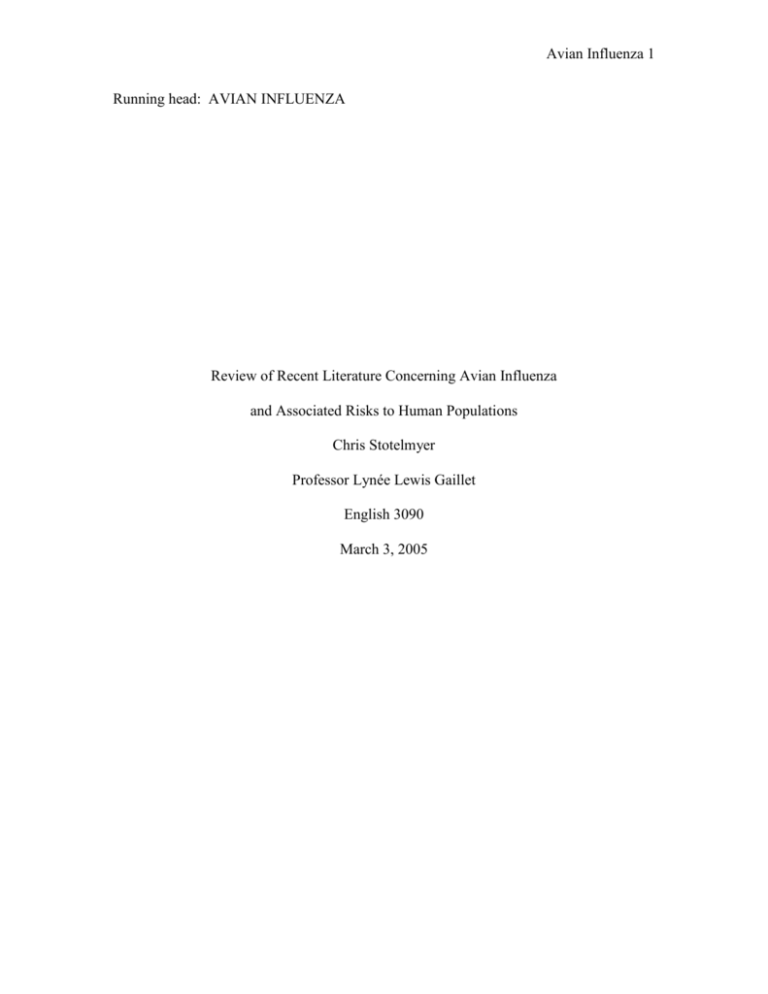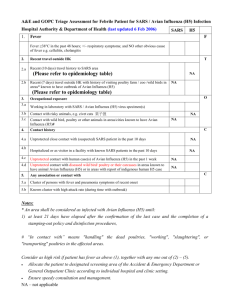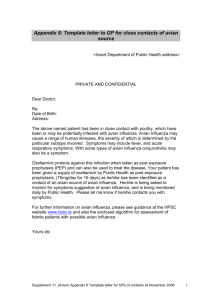Literature Review of Avian Influenza
advertisement

Avian Influenza 1 Running head: AVIAN INFLUENZA Review of Recent Literature Concerning Avian Influenza and Associated Risks to Human Populations Chris Stotelmyer Professor Lynée Lewis Gaillet English 3090 March 3, 2005 Avian Influenza 2 Abstract The total mortality of the 1918 influenza pandemic was roughly 30 million people worldwide. Although subsequent pandemics occurred in Asia in 1957 and 1968, their mortality rates were far less than the 1918 outbreak. The recent emergence of highly virulent strains of avian influenza in Asia has been of increasing concern to public health officials. Scientists believe that another pandemic is inevitable, and that these avian strains may pose the greatest threat of a new, worldwide outbreak of influenza. The shortage of flu vaccine in 2004 has heightened public awareness of a possible pandemic and, as a result, several articles were published in the past year concerning the emerging threat of avian influenza. This review examines those articles to collect and summarize the latest research on the avian influenza threat. Avian Influenza 3 Review of Recent Literature Concerning Avian Influenza And Associated Risks to Human Populations Introduction Influenza has long been present in human populations. The name “influenza,” in fact, is the result of early Renaissance superstition. Astrologers in Renaissance Florence attributed an outbreak of the virus to the malignant “influences” of certain configurations of stars and planets (Collier & Oxford 2000). Science has obviously improved since the Renaissance and our current knowledge of the influenza virus is growing rapidly. The purpose of this paper is to review the most recent (2004-05) literature concerning the possibility of a large-scale outbreak. Scientists have been particularly concerned with the increasing threat of Asian strains of avian influenza or “bird flu.” This paper will focus on those concerns. The Influenza Viruses Influenza viruses are grouped into three major types: influenza A, B, and C. Only influenza A and B regularly infect humans and, between those two, type A is the more significant pathogen (Collier et al. 2000). Influenza A is further categorized by subtype. Two proteins, hemagglutin (H) and neuramidase (N), on the surface of the virus provide scientists with a useful means of identification. Researchers have elucidated fifteen different varieties of the H protein and nine varieties of the N protein. Therefore, a subtype of influenza A is given a specific designation based on these proteins: H1-H15 and N1-N9 (Trampuz, Prabhu, Smith, & Baddour 2004). Furthermore, influenza A is a common pathogen to many mammals including birds, swine, and horses; however, only Avian Influenza 4 subtypes with H1 or H3 proteins are currently active in human populations (Stöhr & Esvald 2004). Pathogenicity of Influenza A A number of influenza A subtypes constantly circulate in human populations without incident because immunity has been established by repeated exposure to the viruses. However, influenza A has demonstrated a remarkable ability to undergo subtle, and sometimes significant, genetic mutations. In fact, annual epidemics arise when these common subtypes undergo enough genetic mutation to produce new strains (Collier et al. 2000). Influenza pandemics, on the other hand, are caused by the rare emergence of a completely new subtype for which the population has no immunity. Klaus Stöhr and Marja Esveld of the World Health Organization (WHO) believe these new viruses are probably derived from the many influenza A subtypes which are known to circulate widely in animals but do not infect humans (2004). If an animal influenza virus manages to cross the species barrier and infect humans, a pandemic may result. Scientists believe that the devastating influenza pandemic of 1918 was probably caused by an animal influenza subtype that had crossed the species barrier. Human populations, therefore, lacked any immunity to this new virus. The new virus’ ability to produce serious illness – its virulence – combined with the fact that the population was immunologically defenseless allowed it to spread rapidly worldwide in only four to six months (World Health Organization 2004, p.79). Interspecies transmission of influenza is also thought to be the cause of the “Asian flu” pandemic of 1957 and the “Hong Kong flu” pandemic of 1968 (Kaye & Pringle 2005). Avian Influenza 5 Avian Influenza A Avian influenza has become a significant concern among scientists. In 1997, 18 people in Hong Kong were hospitalized due to a particularly virulent form of influenza. Six of those individuals died as a result of their illness (Weir et al 2004). Scientists determined that these individuals had been infected with the avian influenza subtype H5N1 and that direct bird to human transmission occurred (Peiris et al. 2004). The significance of the outbreak in Hong Kong is that it was the first documented case of such a transmission. The WHO has been monitoring a highly pathogenic avian influenza (HPAI) H5N1 subtype that has been responsible for an increased number of outbreaks on Asian poultry farms since late 2003 (2004, p.79). H5N1 spreads rapidly in birds and mortality rates can approach 100% (Capua & Alexander 2004). What concerns scientists most is the fact that influenza A subtypes have demonstrated the ability to exchange genetic information when two different viruses have infected the same host. If a human subtype of influenza and an avian strain such as H5N1 were to be present in the same host, genetic interaction can occur. Kaye & Pringle have hypothesized that an intermediate host animal such as swine could provide the means for this kind of genetic exchange (2005). Human Infections with Avian Influenza A Subtypes in 2004 The following is a summary of documented human infections with avian influenza subtypes reported in the literature in 2004: British Columbia Tweed et al. describe two cases of human illness caused by the H7N3 subtype of influenza. A low-mortality outbreak of subtype H7N3 occurred on a poultry farm in Avian Influenza 6 British Columbia on February 6, 2004. The virus was transmitted to an adjacent farm with a dramatic increase in mortality. 2,000 chickens died on this farm in two days. Farm workers were provided with personal protective equipment and were monitored for flu-like symptoms. During the monitoring period 57 workers demonstrated a flu-like illness, and two of those workers tested positive for the H7N3 virus (2004). Thailand In October of 2004 the Ministry of Public Health in Thailand reported that a 9-yearold girl in northern Thailand died of respiratory failure after having been hospitalized with a flu-like illness. The Ministry tested the girl for influenza and found that she had been infected with H5N1. The Thai authorities determined that the girl had been exposed to infected chickens at her home while preparing recently killed birds for cooking. In addition, Thailand had already confirmed 16 cases of human infection with H5N1 between January and October 2004. Eleven of those cases were fatal (World Health Organization 2004, p.377). Viet Nam In January of 2004 the WHO received reports from Hanoi concerning three cases of H5N1 infection in humans. Two children and one adult suffering from a severe respiratory illness were admitted to a hospital in Hanoi. All three patients died of respiratory failure. The Influenza Center of Hong Kong tested samples from the three patients and confirmed that their illness was caused by H5N1 (World Health Organization 2004, p.13). Avian Influenza 7 Discussion Reports of human infection with highly pathogenic H5N1 have slowly increased since the first documented case in 1997. However, two things should be kept in mind when considering these reports. First, advances in technology over the past decade have improved our ability to rapidly and accurately identify this new virus. Second, the WHO has become increasingly vigilant since 1997 and has encouraged Asian countries to carefully document influenza outbreaks. These two factors might explain the increase in the number of cases that have been reported in the literature. In other words, H5N1 may have been present in these countries long before 1997, but cases of human infection went unrecognized. Regardless of how long H5N1 has been present in Asia, the WHO has become increasingly concerned. Outbreaks of H5N1 on poultry farms have been increasing, often with devastating economic repercussions to developing countries – countries whose economies rely heavily on agriculture (WHO 2004, p.78). Developing countries also have fewer resources to deal with outbreaks and to protect agricultural workers from possible infection. Add to this the fact that Asian countries have very high population densities, and it is understandable that the WHO considers H5N1 a significant health concern. Concerns about H5N1 have made the production of a vaccine a priority to the WHO. Vaccines have traditionally been the best defense against influenza; however, no vaccine for H5N1 exists. Attempting to produce a vaccine after a pandemic has erupted would likely be of limited use. Stöhr and Esvald assert that it is political and economic Avian Influenza 8 obstacles, not technological ones, that are responsible for the absence of an H5N1 vaccine: Uncertainty over a viable market prevents companies from investing in pandemic vaccine development, and many governments see no reason to step in, as availability of pandemic vaccines is not considered a public health good (2004, p.2196). In other words, governments and pharmaceutical companies are unwilling to invest in “hypothetical” threats. Fortunately, science has progressed to the point that rapid development of a reference vaccine virus has become a reality. Webby et al. were able to produce such a virus in less than four weeks (2004). Although their research is ongoing and still in its initial stages, the results are encouraging. Research similar to Webby et al. is, at present, the most promising avenue for a rapid response to the avian influenza problem, and further research needs to be encouraged. This technology could also lead to advances in vaccine development for other viruses. All that remains is to convince governments and pharmaceutical companies that a short-term expenditure could avert a significantly greater one in the future. Avian Influenza 9 References Capua, I., & Alexander, D. J. (2004). “Avian influenza: recent developments.” Avian Pathology. 33, 393-404. Collier, L., & Oxford, J. (2000). Human Virology. New York: Oxford. Hirst, M., et. al. (2004). “Novel avian influenza H7N3 strain outbreak, British Columbia.” Emerging Infectious Diseases. 10, 2192-95. Kaye, D., & Pringle, C. R. (2005). “Avian influenza viruses and their implication for human health.” Clinical Infectious Diseases. 40, 108-12. Peiris J. S. M., et. al. (2004). “Re-emergence of fatal human influenza A subtype H5N1 disease.” The Lancet. 363, 617-19. Stöhr, K., & Esveld, M. (2004). “Will vaccines be available for the next influenza pandemic?” Science. 306, 2195-96. Trampuz, A., Prabhu, R. M., Smith, T. F., Baddour, L. M. (2004). “Avian influenza: A new pandemic threat?” Mayo Clinic Proceedings. 79, 523-30. Tweed, S. A., et. al. (2004). “Human illness from avian influenza H7N3, British Columbia.” Emerging Infectious Diseases. 10, 2196-99. Webby, R. J., et. al. (2004). “Responsiveness to a pandemic alert: use of reverse genetics for rapid development of influenza vaccines.” The Lancet. 363, 1099-1103. Weir, E., Wong, T., & Gemmill, I. (2004). “Avian influenza outbreak: update.” Canadian Medical Association Journal. 170, 785-6. World Health Organization. (2004). “Avian influenza A(H5N1) in humans and poultry, Viet Nam.” Weekly Epidemiological Report. 79, 13-4. Avian Influenza 10 World Health Organization. (2004). “Avian influenza A(H5N1) – situation on 4 February 2004.” Weekly Epidemiological Report. 79, 53-4. World Health Organization. (2004). “Avian influenza A(H5N1).” Weekly Epidemiological Report. 79, 65-70. World Health Organization. (2004). “Avian influenza frequently asked questions.” Weekly Epidemiological Report. 79, 77-83. World Health Organization. (2004). “Assessment of risk to human health associated with outbreaks of highly pathogenic H5N1 avian influenza in poultry – Situation as at 14 May 2004.” Weekly Epidemiological Report. 79, 203-4. World Health Organization. (2004). “Avian influenza, Thailand.” Weekly Epidemiological Report. 79, 377-8.




